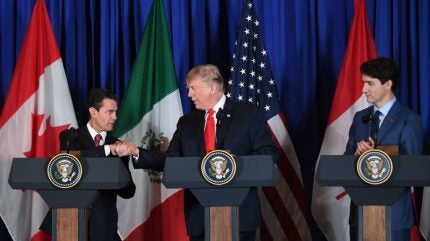

As the first wave of Covid-19 hit in the early months of 2020, governments around the world took emergency measures to limit the spread, secure vital supplies and cushion their citizens from the economic impact.
Many of these measures not only damaged the profits of international investors, but potentially breached their rights under investment treaties. In the weeks and months since then, a number of leading law firms have started advising foreign investors affected by such measures how and when they could sue governments for these breaches.
Investment treaties, and particularly clauses that commit states to binding investor-state dispute resolutions (ISDS), are already under close scrutiny. Controversial lawsuits targeting public health and environmental regulations have precipitated a series of unilateral terminations by developing countries. At the same time, the treaties’ dubious effectiveness and potential downsides have resulted in growing scepticism within the US and EU.
Now, experts and civil society groups have warned that investment treaty claims relating to pandemic response measures could push teetering economies over the brink, and are calling for an immediate moratorium on ISDS. If a wave of pandemic-related claims does materialise, ISDS may suffer an irreversible hit from global public opinion.
The grand bilateral treaty bargain
In an investment treaty, the vast majority of which are bilateral, countries or states promise to treat their investors according to certain standards throughout the lifetime of their investment. In order to make these promises credible, most treaties include a statement of consent binding any investor-state dispute settlement. If the state is found to have violated the treaty, arbitrators can award the investor sums in the millions or billions of dollars, depending on the damage caused.
ISDS benefits investors in that it removes the need to go through their home government in order to attain redress at the international level. Moreover, the awards are legally enforceable – in the event of non-payment, investors are entitled to seize the international commercial assets of the respondent country.
How well do you really know your competitors?
Access the most comprehensive Company Profiles on the market, powered by GlobalData. Save hours of research. Gain competitive edge.

Thank you!
Your download email will arrive shortly
Not ready to buy yet? Download a free sample
We are confident about the unique quality of our Company Profiles. However, we want you to make the most beneficial decision for your business, so we offer a free sample that you can download by submitting the below form
By GlobalDataIn theory, this should encourage inward investment. Even where investors aren’t paying attention to the signing of investment treaties, the reduced political risk should be reflected in lower insurance premiums. In the case of Germany’s state-sponsored investment insurance, the presence of a bilateral investment treaty (BIT) was a prerequisite for having any coverage whatsoever.
This exchange of sovereignty for inward investment has been described as the ‘grand bargain’ of the investment treaty regime.
Do treaties attract investment?
The perceived wisdom used to be that this bargain was worth it for countries looking to secure inward FDI.
The number of BITs grew exponentially from 1986 to 1996, driven in no small part by the enthusiasm of developing states eager to shed a reputation for mass expropriations and demonstrate their commitment to the new US hegemony.
It was no surprise to economists that this ‘BIT mania’ was accompanied by a surge in global FDI flows, as per the chart below.
Recently, however, experts have come to doubt this story. Scores of studies have examined the relationship between BITs and FDI, but these tend to show correlation rather than causation.
While the FDI surge in the 1990s did coincide with the signing of BITs, it also coincided with many other policies that might explain it, such as financial liberalisation, deregulation and privatisation. Causation might also run in the wrong direction, with growth in bilateral FDI prompting two countries to sign a BIT. An influential study by economist Emma Aisbett found that when these factors are accounted for, the apparent effect of BITs on FDI disappears.
The importance of these factors is evident in the fact that countries that did not sign BITs also saw a huge surge in FDI. Even Brazil, which did not sign a single BIT during this period, witnessed the same wave of inward investment.
Another issue is the failure to distinguish between types of BIT. The theoretical argument that BITs promote investment by disincentivising ill-treatment of investors depends on the treaty containing a commitment to binding arbitration. However, earlier generations of BIT contained no such commitment. When only ‘strong’ BITs are included in the analysis, a different study found, the effect again disappears.
Economists Josef Brada, Zdenek Drabek and Ichiro Iwasaki recently conducted the first comprehensive synthesis of the quantitative literature, analysing 2,107 estimates drawn from 74 studies. The authors found that the average effect of BITs on inward FDI is so small as to be considered non-existent, regardless of the wording of the treaty or the methodology used in the study.
Investors pay little attention to BITs
The apparent lack of a correlation when adjusting for these factors is likely a result of the fact that investors simply do not pay much attention to investment treaties.
In the early 1990s, a series of World Bank studies found that Western investors had little awareness of the nascent investment treaty regime. Similarly, there is surprisingly little evidence to suggest that corporate interests played any significant role in lobbying for the 1990s expansion of the treaty regime.
Even as late as 2005, white-shoe law firm Allen & Overy was describing BITs to its clients as “these little-known treaties [that] may give you […] rights you never knew you had”.
In 2011, a survey sent to the general counsel of the top 200 US companies found that few were familiar with BITs and only 4% could recall a situation in which their company had declined to invest in a country due to the absence of a BIT. Respondents also had a dim view of the effectiveness of BITs in preventing either expropriation or regulatory changes.
Similarly, a 2012 study for the European Commission found that 46% of European investors in China were entirely unfamiliar with the BIT between their country and China, while 42% considered BITs entirely unimportant to their investment decisions.
ISDS is inaccessible to all but the largest investors
Brada and colleagues did find a small, positive effect on inward FDI for those countries that signed treaties with advanced economies. This could suggest that investors in developing economies pay less heed to political risk, but it more likely reflects the exorbitant costs associated with making use of the treaties’ dispute mechanisms. Companies with more than $1bn in annual revenue and individuals with over $100m in personal wealth have received 94% of all ISDS compensation.
Investment treaties are therefore unlikely to affect the investment decisions of any but the largest investors, with others effectively locked out of the system. The largest business group in Europe, the German Association of Small and Medium-Sized Enterprises, has lobbied forcefully against ISDS on exactly these grounds.
Not all investors are vulnerable to expropriation
Another reason why the observed effect is so small relates to a fundamental issue with FDI data –the failure to distinguish between fixed and liquid assets.
The issue that treaties are meant to solve, the post-establishment shift in bargaining power from investor to state, is conditional on the investment’s liquidity. The easier it is for an investor to move an asset out of the country, the harder it is for the host state to tighten the screws without provoking capital flight. While mines and factories cannot simply be packed up and moved if conditions change, cash reserves and intellectual property can.
Official FDI statistics, however, do not generally distinguish between fixed and liquid assets. Cash reserves and intellectual property held by a multinational abroad are counted the same as roads and railways. In low-tax jurisdictions, for instance, cash reserves are likely to constitute a large portion of the inward FDI stock, and so investment treaties may be less effective.
One approach to solving this problem is to use industry data as a proxy for asset liquidity, as investment protections should have a greater effect on investment by industries that make greater use of fixed, immobile capital.
Although FDI data disaggregated by sector is not yet widely available, the few studies that have examined this question have found exactly what might be expected – that the only industries in which BITs increase investment are resource extraction and infrastructure, the industries that also make the greatest use of fixed capital. Laying down power lines, pipes and mineshafts is a long-term investment, requiring a high level of confidence in economic and political stability.
This also fits with the observation that sectors with highly immobile investments – such as utilities and energy – have constituted 68% of all ISDS cases. Investors in sectors such as finance, law, light manufacturing and retail are much less likely to be swayed by an investment treaty.
There are many alternatives to investment treaties
The lack of interest among investors may also stem from the availability of other avenues for protection. In many states, domestic laws offer a sufficient defence. Where this is not the case, investors with highly immobile assets are likely to consider an investor-state contract or investment insurance.
International arbitration is likely to be a last resort. Most investors would be wary of the effects that litigation could have on their future relationship with the host state, preferring to deal with disputes discreetly where possible.
This may be why, contrary to expectations, BITs seem to have little impact on the pricing of political risk insurance. In 2010, political economist Lauge Poulsen conducted a series of in-depth interviews with investment insurers and found that the vast majority reported paying little heed to the presence or absence of a BIT.
A 2011 study reported similar findings, with one private underwriter explaining that prices were much more likely to be influenced by factors such as the character of the incumbent government, the levels of corruption, the economic situation of the country and fluctuations in commodity prices.
Finally, even for large investors looking to place very immobile assets in risky jurisdictions, launching an investment dispute is high risk. Tribunals are typically run on an ad hoc basis, meaning that there is no requirement for arbitrators to refer to case law or maintain consistency across rulings. Moreover, BITs are often vaguely worded, with key provisions such as ‘fair and equitable treatment’ left largely underspecified. Together, these two facts make it extremely difficult to predict the outcome of a dispute.
Nonetheless, for the very largest investors the sheer size of the potential awards could justify this level of risk.
Testing whether BITs actually do affect the decisions of this tiny subset of investors, however, has proven next to impossible with the currently available data. Official FDI statistics do not distinguish between sectors, between fixed and liquid capital, or between large and small investors. Project-level datasets are becoming increasingly detailed and comprehensive, however, and could soon help to bridge this impasse.
The BIT backlash
The lack of an obvious positive effect on inward investment, however, isn’t enough to explain the strength of the backlash against investment treaties in recent years. Rather, the rollback of the investment treaty regime was occasioned by an explosion of investor-state disputes that only began years after most treaties were signed.
The annual number of disputes soared from just four in 1995 to 43 in 2003, but this was not due to any surge in outright expropriations. While there were a few such cases, many of the claims were based on alleged breaches of treaty provisions concerning ‘indirect expropriation’ or ‘fair and equitable treatment’ – vague terms that have given investors broad scope to challenge government actions.
Some of the most controversial cases have involved investors challenging environmental regulations. For instance, after granting preliminary approval for US company Bilcon to open a quarry in Nova Scotia, a routine environmental review rejected the application on the basis that it would result in “significant adverse environmental effects”, including the destruction of the habitats of endangered species. Bilcon subsequently sued the Canadian government under the North America Free Trade Agreement’s (Nafta’s) investment chapter, arguing that it had a “legitimate expectation” that the application would be approved, and received $7m in damages plus interest.
In 52% of cases the tribunals have either ruled in favour of the investor, or the parties have reached an outside settlement. Even where the state wins, costs average more than $8m, with Australia recently having to spend more than $24m defending its decision to introduce plain packaging on tobacco products.
The evidence suggests that World Bank advisors, among others, significantly overstated the ability of BITs to attract inward investment, while the countries themselves often failed to anticipate the scale of the awards.
Apparently viewing the treaties as a form of soft law, capital-importing countries frequently delegated bureaucrats, rather than legal experts, to BIT negotiations. As one South Korean negotiator explained to Poulsen: “Until recently most Korean experts of international litigation […] were found only in the private sector and not in the government… Negotiators were often unable to adequately address the complex procedural issues surrounding investor-state dispute resolution.”
Many of these treaties had been negotiated in one or two days, and states were happy to use off-the-shelf European models. One South African negotiator found the approach of Canada, which wanted to use its own model, frustrating, explaining to Poulsen: “These were people who took BITs as real and serious legal instruments with teeth, rather than what they really are, namely pure signals… Why be so pedantic and difficult in worrying so much about the legal details? It was very difficult.”
Nonetheless, by the late 2000s it was clear that these treaties were anything but mere signals, and many developing countries were already reconsidering their investment treaties. In South Africa and Ecuador, comprehensive government cost-benefit reviews recommended that governments roll back their treaty commitments to investor-state arbitration.
Ecuador subsequently withdrew entirely from the International Centre for Settlement of Investment Disputes, a major arbitration venue, along with Venezuela and Bolivia, while South Africa has joined Indonesia, India and Tanzania in unilaterally terminating many of its BITs. These unilateral terminations haven’t had any appreciable negative effect on bilateral FDI flows, which have actually been more likely to increase than to decrease.
Similarly, ISDS has fallen out of favour with countries negotiating new investment treaties. The recently signed Brazil-India BIT leaves dispute resolution to states, while the Regional Comprehensive Economic Partnership, a major agreement between 15 Pacific economies, is similarly expected to exclude ISDS.
Even staunch capitalists are turning against ISDS
Another issue raised by critics is the fact that the treaty system privileges foreign investors over domestic investors – unless those domestic investors are willing to be creative with their ownership structure.
In 2013, Canadian energy company Lone Pine was threatened by Quebec’s introduction of a moratorium on fracking. Formally registered in the US state of Delaware, the company was able to use Nafta’s investment chapter to launch proceedings against the Canadian government as a foreign investor, acknowledging that the nature of the Canadian constitution would have rendered a fight in the domestic courts more difficult.
On this matter, ISDS has attracted opposition from even the staunchest defenders of globalised capitalism. Robert Lighthizer, the US trade representative under Donald Trump, has argued that ISDS distorts the international investment market by acting as a de facto subsidy to foreign investors. The same argument has been made by the Cato Institute, a right wing libertarian think tank based in Washington, DC.
It may be desirable to subsidise certain types of foreign investment; for instance, those which promote development or decarbonisation. Among the greatest beneficiaries of ISDS, however, are oil and gas companies – multinational giants that often operate with high sunk costs in risky jurisdictions, but which threaten both local ecosystems and the global climate.
An uncertain future
The Trump administration’s renegotiation of Nafta, an unparalleled source of disputes, produced a new treaty with no ISDS provisions for US investors in Canada, while US investors in Mexico must now exhaust the options available in Mexico’s legal system before filing a dispute.
In contrast, the EU is pushing for reform over revolution. The European Commission has proposed replacing ISDS with a multilateral investment court (MIC), established on a permanent rather than ad hoc basis, and with judges paid a salary rather than a piece rate. A similar system has already been established in CETA, the EU’s trade agreement with Canada, and is planned for the Energy Charter Treaty.
While an MIC would go some way towards addressing concerns about the system’s transparency, leaked negotiating papers show that Lighthizer’s office has strongly opposed the plan.
The EU and US may converge on a reform agenda under the Biden administration, however. While President-elect Joe Biden has said he will oppose the inclusion of ISDS in future trade agreements, it is unclear whether he will roll back existing treaty commitments to the mechanism.
Whatever attitude the new administration brings, the investment treaty regime is now firmly on the back foot. The settling of the empirical debate as to their effects has taken the wind out of its sails, while the persistent legitimacy challenges that have dogged the system may well intensify if the coming slump is greeted with a litany of controversial pandemic-related disputes.






